Buying guide for 3D printing consumables
There are many consumables available for 3D printing, and their number is steadily increasing. So, you have a choice, and this guide is intended to guide you in the acquisition of consumables by giving you all the information you need.
The most common printers which deposit melted filaments (FDM) use 3D filaments. The range of materials available to buy is very large for 3D filaments. Each filament type has its own characteristics, advantages and limitations. You are making a mechanical prototype or finished parts, simple or complex printing, you have a heated plate or not, your printer can print at a temperature of 260° C or 300° C ... all these parameters, and many others, need to be taken into account when you buy your 3D filament, and this guide will help you.
Other 3D printers use a different type of consumable: resin. Resins are designed for 3D printers using SLA / DLP (laser or video projector) technology, such as the Form 2 by Formlabs. As with 3D filaments, there are several kinds of resins, however, the current choice is a bit more restricted, mainly concerning the colours. Nevertheless, you can buy normal, flexible, castable and highly resistant resins, enough to fulfil most rapid prototyping needs! The selection criteria depend on your use, and you may well be interested in reading this guide before buying resin.
The information and advice provided in this guide will help you to be more familiar with consumables, and guide you in buying your consumables for your 3D prints.
3D filament guide
PLA filament guide
PLA filament presentation
PLA 3D filament (Polylactic Acid) is a bioplastic made from recycled products or corn starch. It is biodegradable and has a pleasant scent when printing. This is by far the most widely used desktop 3D printing material due to its printing simplicity, the fact that it is natural and odourless, and its ability to faithfully retain the dimensions.
PLA filament characteristics| Printing ease: |  | | Mechanical strength: |  | | Recommended print speed: | 50 mm/s to 120 mm/s | | Extrusion temperature: | 180° C to 220° C | | Bed temperature: | Room temperature to 60° C |
| 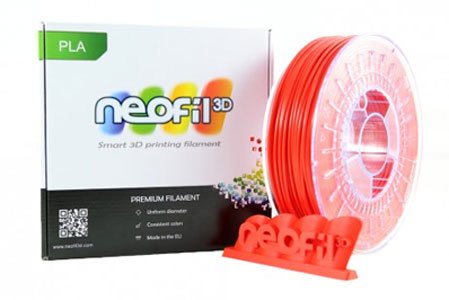 |
Advantages of PLA- Very easy to use
- Does not require a heated bed (compatible with multiple 3D printers)
- Few failures due to thermal variation
- Little risk of deformation
- Consistent print quality
- Stiff material
- Easy post-processing: PLA can be polished, varnished and painted
| Limitations of PLA- Not very heat resistant (softens around 50°)
- More likely to break than bend
- Sensitive to moisture (store in a dry place)
|
When to use PLA filament?PLA is the most used material for 3D printing, and not only for its ease of printing, as it's suitable for many uses. Generally speaking, you can use PLA for any use not subject to significant mechanical forces, or intended for outdoor use. Decoration, utensils, finished parts, marketing & communication, modelling, architectural models, etc. In addition, its propensity for retaining dimensions makes it ideal for non-mechanical, functional prototypes. | Tips for PLA- Use tape to help the adhesion of PLA on unheated beds
- Possibly use adhesive spray to help hold large-sized pieces
- Do not overheat, usually a temperature of 200/210° C is sufficient
- If you need to test the maximum print speed of your printer, PLA is ideal
|
ABS filament guide
ABS filament presentation
ABS 3D filament (Acrylonitrile Butadiene Styrene) is a durable and impact-resistant thermoplastic. It is found everywhere in everyday life (for example, in household appliances and industry in general).
ABS filament characteristics| Printing ease: |  | | Mechanical strength: |  | | Recommended print speed: | 40 mm/s to 80 mm/s | | Extrusion temperature: | 220° C to 240° C | | Bed temperature: | 70° C to 110° C |
| 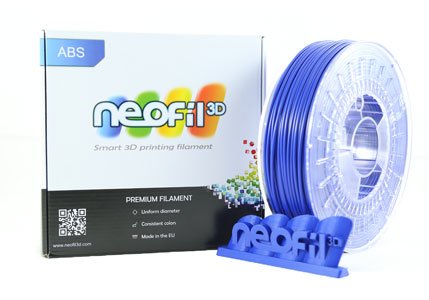 |
Advantages of ABS- Shock resistant
- Durable
- Heat resistant
- More likely to bend than break - mechanical strength
- Easy post-processing: ABS can be filed, sanded and painted
- Easy to clean
- Resistant in outdoor environments
| Limitations of ABS
- Petroleum-based plastic, non-biodegradable
- Requires a heated bed
- Subject to the risk of thermal variation during printing
- Risk of deformation and detachment of the printed parts (warping). This makes it difficult to print.
|
When to use ABS filament?ABS is ideal for designing industrial prototypes, mechanical parts, gardening, DIY, everyday items, toys, etc. Very common, it is found in many everyday objects because of its widespread use in industry. These include the type of plastic used to make the famous LEGO. | Tips & tricks for printing with ABS- At least use a spray adhesive, even UHU type glue, on the heated bed (tape is ineffective)
- As a last resort, an "ABS slurry" (ABS diluted with acetone) can be used to ensure the ABS sticks to the bed.
- Protect from draughts when printing.
- Print in a room at room temperature (ABS does not like the cold when printing)
- It is possible to smooth the outer surface of printed ABS products by applying acetone to it ("crude" or spray).
- To further personalise your creations and give them a completely finalised rendering by painting your prints, it is recommended that you use acrylic paint
- To clean or unclog your extrusion heads, use acetone.
|
Nylon filament guide
Nylon filament presentation
NYLON 3D filament is a plastic in the polyamide family (artificially produced by polymerisation). It is often found in the textile and automotive industries, for example. Taulman is, to date, the main brand offering Nylon filament for 3D printing.
Nylon filament characteristics| Printing ease: |  | | Mechanical strength: |  | | Recommended print speed: | 30 mm/s to 60 mm/s | | Extrusion temperature: | 235° C to 260° C | | Bed temperature: | Room temperature to 60° C |
| 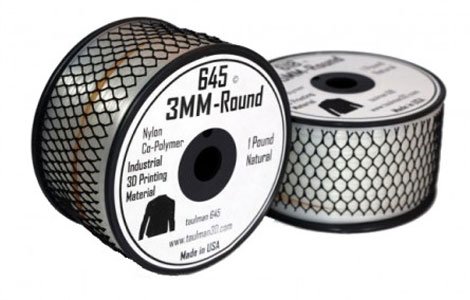 |
Advantages of Nylon- Extremely strong and flexible
- Durable
- Low odour
| Limitations of Nylon
- Highly flammable
- Sensitive to moisture
|
When to use Nylon filament?Nylon filament is ideal for prints requiring great strength and some flexibility. It can, therefore, be used for making durable and strong mechanical parts. | Tips & tricks for printing with Nylon filament- You can dye your Nylon prints using textile dye, which will give you an infinite number of colours to your prints
- For best results, it is possible to dry the filament in the oven before printing (150° C). This way you remove the moisture that could become integrated into the material.
|
PET / PETG filament guide
PET / PETG filament presentation
PET / PETG 3D filament (polyethylene terephthalate), is the most common thermoplastic polyester and is the most used material for sparkling water bottles. This is indeed a food-grade plastic approved by the FDA that is found in a lot food packaging.
PET / PETG filament characteristics| Printing ease: |  | | Mechanical strength: |  | | Recommended print speed: | 30 mm/s to 60 mm/s | | Extrusion temperature: | 240° C to 260° C | | Bed temperature: | 50 to 70° C |
| 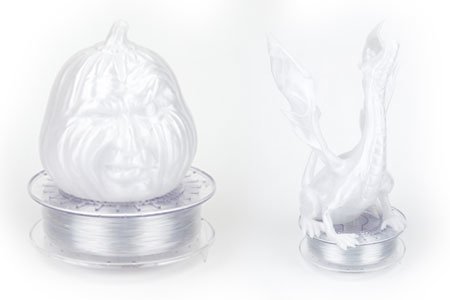 |
Advantages of PET / PETG- Food contact compatible
- Lightweight and translucent
- Extremely strong and impenetrable for many gases, such as CO2
- Good electrical insulator
| Limitations of PET / PETG
- Apart from some technical printing, nothing specific
|
When to use PET / PETG filament?PET filament can be used for food containers, designing fashion jewellery, electrical components, or any other creation requiring transparency, toughness, sealing or food contact. | Tips & tricks for printing with PET / PETG filament- Do not hesitate to increase the number of outer layers (shells) for a good seal
- Translucency is only obtained with the printing of one or two shells
- Print very slowly
|
Flexible filament guide
Flexible filament presentation
Formulated from thermoplastic elastomer (TPE), flexible (and elastic) 3D filament truly brings a new dimension to desktop 3D printing. Some brands stand out for this type of material: FilaFlex , NinjaFlex or Polymaker for its really easy to print and very high quality flexible filament.
Flexible filament characteristics| Printing ease: |  | | Mechanical strength: |  | | Recommended print speed: | 30 mm/s | | Extrusion temperature: | 180° C to 240° C | | Bed temperature: | 70 to 100° C |
| 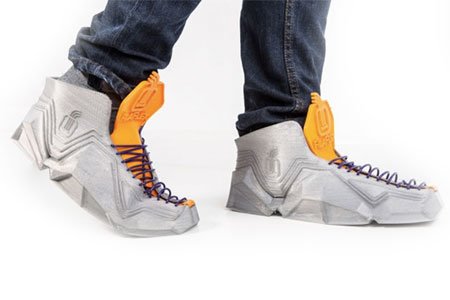 |
Advantages of flexible filament
- Flexible and elastic
- Regains its shape after deformation
- Compatible with most 3D printers that have a heated bed
- Offers a high resistance to heat, water and wear
| Limitations of flexible filament
- Mandatory slow print speed (30 mm/s)
- a lot of stringing depending on the type piece printed: plan post-processing
|
When to use flexible filament?Flexible filament allows you to print objects that can stretch, twist and bend without breaking, such as soft shoes, elastic belts, shoe soles, grips, tires, etc. | Tips & tricks for printing with flexible filament- Print pieces one by one to avoid stringing
- Lubricate the filament access tubes to the extruder (bowden tubes) in order to limit friction of the filament against these tubes.
- Print very slowly
|
Wood filament guide
Wood filament presentation
Wood filaments, originally known through Laywoo by many makers, is a filament made of a PLA and wood powder composite. The amount of wood powder contained in a wood composite filament is generally between 25 and 40%.
Wood filament characteristics| Printing ease: |  | | Mechanical strength: |  | | Recommended print speed: | 30 mm/s to 50 mm/s | | Extrusion temperature: | 180° C to 240° C | | Bed temperature: | Room temperature to 60° C |
| 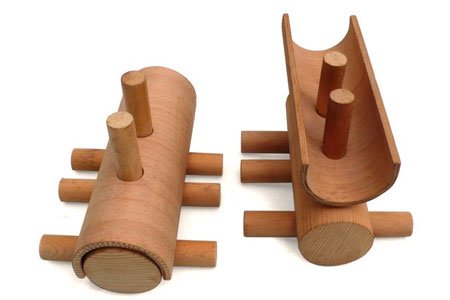 |
Advantages of Wood filament
- Wooden rendering for your prints
- Pleasant woody odour when printing
- Good adhesion to the bed (similar to PLA)
| Limitations of Wood filament
- You need to wait until the printed object has cooled before handling it: risk of deformation
- No printing below 150 micron layer height
|
When to use Wood filament?Wood filament is a perfect filament for prints with decorative purposes, or, for example, for architectural models with wood. | Tips & tricks for printing with Wood filament- The colour of your wood printed piece will vary according to your extrusion temperature
- Accordingly, by varying the temperature during printing you can get different shades on a single piece
- Since the filament is made of particles, it must be printed with 150 micron or greater layer height.
- Easy, complete post-processing
|
Stone filament guide
Stone filament presentation
Stone filaments, known through "Laybrick" by users of 3D printers, is a filament made of a PLA and stone powder composite (stoneware). The amount of stone powder in a stone composite filament is usually between 25 and 40%.
Stone filament characteristics| Printing ease: |  | | Mechanical strength: |  | | Recommended print speed: | 30 mm/s to 50 mm/s | | Extrusion temperature: | 180° C to 240° C | | Bed temperature: | Room temperature to 60° C |
| 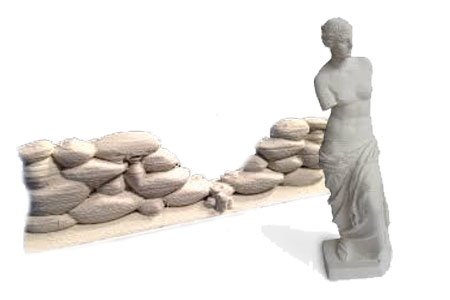 |
Advantages of Stone filament
- Stone rendering of your prints
- Good adhesion to the bed (similar to PLA)
| Limitations of Stone filament
- You need to wait until the printed object has cooled before handling it: risk of deformation
- No printing below 150 micron layer height
|
When to use Stone filament?Stone composite filament is a perfect filament for prints with decorative purposes, or, for example, for architectural models, statues, etc. | Tips & tricks for printing with Stone filament- For optimum effect when getting started, increase the fill rate for your Stone prints so that the weight is closer to a Stone object
- Since the filament is made of particles, it must be printed with 150 micron or greater layer height.
- Easy, complete post-processing
|
Metal filaments guide
Metal composite filaments guide
Metal filaments are composites of PLA and various metals. Metal filament can be found with the following metals: bronze filament, carbon filament, copper, stainless steel, brass and iron filament.
Please note: metal filaments have different characteristics depending on the metal used: for example, carbon will be a little trickier to print but very strong! Bronze filaments are rather decorative, copper and iron filaments have electrical transmission properties, etc.
Characteristics of metal filaments| Printing ease: |  | | Mechanical strength: |  | | Recommended print speed: | 30 mm/s to 50 mm/s | | Extrusion temperature: | 195° C to 220° C | | Bed temperature: | Room temperature to 60° C |
| 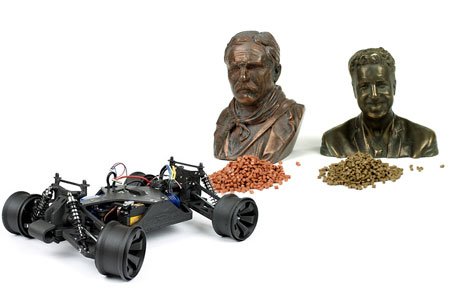 |
Advantages of metal filament
- Heavy, dense results
- Wide selection of metals to have extremely strong parts (Carbon), impressive decorative effects (Bronze, Copper, Brass), conductive properties, etc.
- Post processing: possibility of brushing and polishing objects printed with this filament
| Limitations of Metal filament
- Some may be fragile
- Abrasive! Especially carbon. You need to print with metal, not brass, nozzles if you don't want to have to replace it every three prints.
- Minimum 150 micron layer height
|
When to use metal composite filament?Metal filaments provide the aesthetics and density of metal. They are perfect for jewellery, costumes, accessories, figurines, crafts, robots, and more. | Tips & tricks for printing with metal filament- Minimum 150 micron layer height
- The patina can be sanded, polished for a truly stunning effect
- For the more abrasive ones, change the brass nozzle with a steel nozzle
|
Porous filament guide
Presentation of porous filaments
Porous filament (LayFelt, LayFomm, Porous) is made from an elastomeric polymer (rubber type) and a PVA component. This means that part of this filament is soluble in water. Composed of foam, it has similar characteristics to felt, it contains stiff/flexible fibres with a "felt" appearance.
Characteristics of porous filaments| Printing ease: |  | | Mechanical strength: |  | | Recommended print speed: | 40 mm/s to 80 mm/s | | Extrusion temperature: | 180° C to 240° C | | Bed temperature: | Room temperature to 60° C |
| 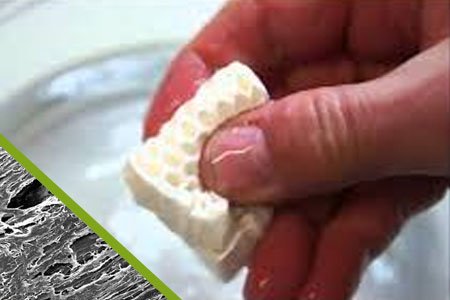 |
Advantages of porous filament
- Extremely flexible
- Partially soluble in water (PVA)
| Limitations of porous filament
- Not necessarily so easy to print, depending on the printer
- Finding its application...
|
When to use porous filament?The function of this material makes it ideal for printer filters, flexible objects like those used in biological, physical and chemical sciences (3D membranes, semi-permeable membranes, artificial paper and foldable felt fabrics). It is also very suitable for use in water treatment membranes, or electro-cells. | Tips & tricks for printing with porous filament- Once you rinse this material in water, the PVA component dissolves and the elastomeric polymer remains and makes your object fibrous/microporous
- For better results and maximum flexibility of the printed object, we recommend immersing the print in a bowl of tap water for 1-4 days
|
SLA resin guide
SLA resins are only designed for 3D printers using SLA / DLP (laser or video projector) technology. Combined with the high-precision laser of stereolithography 3D printers, they provide an incomparable finishing quality and level of detail!
Guide to "conventional" resins
Presentation of conventional SLA resins
"Conventional" resins (not flexible, castable, etc.) are photosensitive resins designed for all your creations with a 3D printer using SLA technology. The resins provide prints of the highest quality and durability. If you use a Form 1+, we recommend Formlabs resins. Not only are they adapted to the machine, but they are also, quite simply, top quality!
Characteristics of conventional resins| Printing ease*: |  | * Resins themselves do not cause any printing problems. The key to succeeding at printing with SLA technology lies in the positioning of the piece and supports.
| | Mechanical strength: |  | Advantages of conventional resins
- Strong and sturdy
- Can be painted easily
- Provides exceptional fineness and professional renderings
Limitations of conventional resins
- More post-processing than FDM
|
| 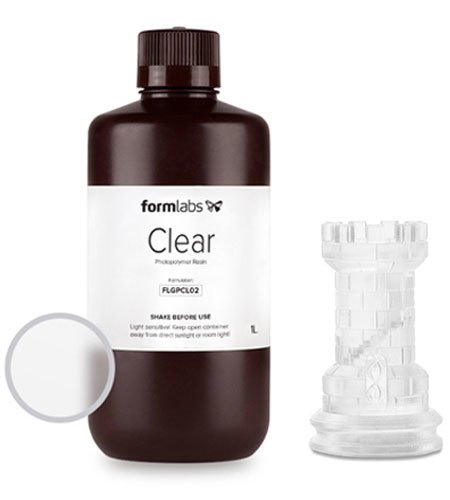 |
When to use SLA resins?Conventional resins are suitable for all types of use. | Tips & tricks for printing with SLA resins- Safety instructions must be followed when using conventional resin on your 3D printer, gloves and goggles must be worn when handling
|
Castable resin guide
Presentation of castable resins
Castable resin is a resin that can be burned to create moulds of your printed pieces. It is especially interesting for the dental industry and jewellers.
Characteristics of castable resins| Printing ease*: |  | *Castable resins themselves do not cause any printing problems. The key lies in the burning and the equipment required to carry it out.
| | Mechanical strength: |  |
| 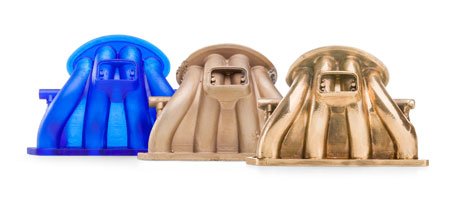 |
Advantages of castable resins
- Creation of moulds from your prints
- Provides exceptional fineness and professional renderings
| Limitations of castable resins
- More post-processing than FDM
- be equipped with the necessary equipment, in particular, an oven
|
When to use castable resins?The usefulness of castable resins essentially lies in their ability to burn cleanly and retain a very high level of detail, so as to create a mould from your printed piece. | Tips & tricks for printing with castable resins- You need to be patient at the beginning and have the required equipment or you will not get good results from this very technical kind of resin.
|
Flexible resin guide
Presentation of flexible resin
With a 90% elongation rate for Formlabs resins, for example, flexible resins are designed for very elastic creations with shape memory.
Characteristics of flexible resin| Printing ease*: |  | * Flexible resins themselves do not cause any printing problems. The key to succeeding at printing with SLA technology lies in the positioning of the piece and supports.
| | Mechanical strength: |  |
| 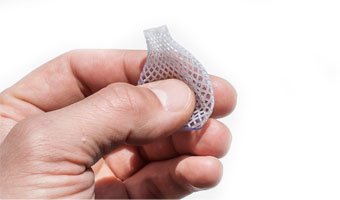 |
Advantages of flexible resin
- High elasticity and shape memory
- Prints very easily
- Impact resistant
- Some surface treatment
| Limitations of flexible resins
- Low resistance to handling
|
When to use flexible resins?Flexible resin is great for prototyping, product design and engineering (handles, grips, gaskets, moulds, prototyping soft overmoulding, etc.). | Tips & tricks for printing with flexible resin- Safety rules must be followed when using flexible resin on your 3D printer, gloves and goggles must be worn when handling.
|
Tough resin guide
Presentation of Tough by Formlabs
Tough resin by Formlabs was specifically designed to deliver rock solid strength. This is an ultra-strong resin for mechanical applications, robotics, etc.
Characteristics of Tough resin by Formlabs| Printing ease*: |  | * Flexible resins themselves do not cause any printing problems. The key to succeeding at printing with SLA technology lies in the positioning of the piece and supports.
| | Mechanical strength: |  |
| 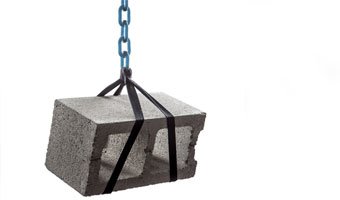 |
Advantages of Tough resin
- Ultra-strong, quite impressive.
- Prints very easily
| Limitations of Tough resin
- Honestly?...We can't find any.
|
When to use Tough resin?Tough resin is the solution for all engineering and mechanical prototyping needs. For example, no member of Makershop could break by hand a closed chain composed of a dozen links (printed at once). | Tips & tricks for printing with flexible resin- Safety rules must be followed when using flexible resin on your 3D printer, gloves and goggles must be worn when handling.
|
@Copyright: All content present on www.makershop3d.com is the property of Makershop. It is strictly prohibited to copy, completely or partially, the content present on www.makershop3d.com, or face sanctions. Content copy checks are carried out regularly.












